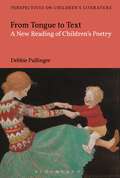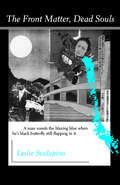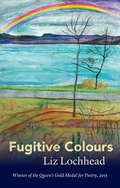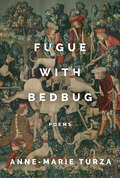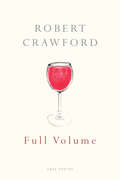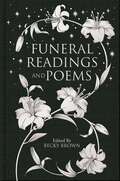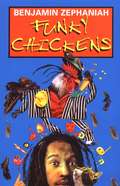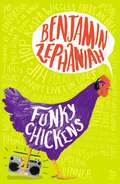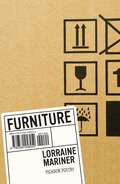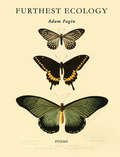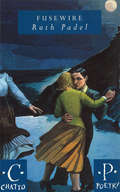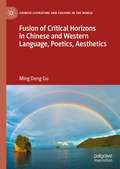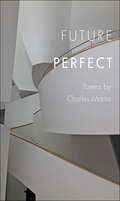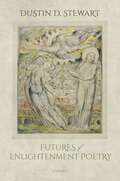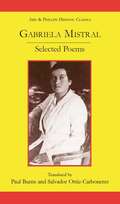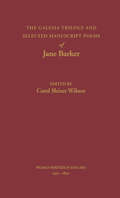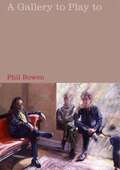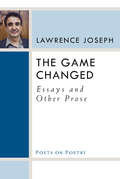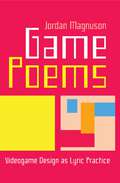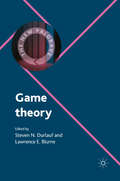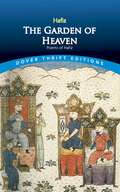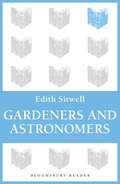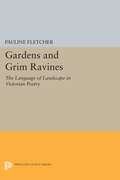- Table View
- List View
From Tongue to Text: A New Reading of Children's Poetry (Bloomsbury Perspectives on Children's Literature)
by Dr Debbie PullingerThe connection between childhood and poetry runs deep. And yet, poetry written for children has been neglected by criticism and resists prevailing theories of children's literature. Drawing on Walter Ong's theory of orality and on Iain McGilChrist's work on brain function, this book develops a new theoretical framework for the study of children's poetry. From Tongue to Text argues that the poem is a multimodal form that exists in the borderlands between the world of experience and the world of language and between orality and literacy – places that children themselves inhabit. Engaging with a wide range of poetry from nursery rhymes and Christina Rossetti to Michael Rosen and Carol Ann Duffy, Debbie Pullinger demonstrates how these 'tactful' works are shaped by the dynamics of orality and textuality.
The Front Matter, Dead Souls (Wesleyan Poetry Series)
by Leslie ScalapinoLeslie Scalapino is widely regarded as one of the best avant-garde writers in America today. This extraordinary new book is essay-fiction-poetry, an experiment in form, "a serial novel for publication in the newspaper" that collapses the distinction between documentary and fiction. Loosely set in Los Angeles, the book scrutinizes our image-making, producing extreme and vivid images-hyena, Muscle Beach in Venice, the Supreme Court, subway rides-in order for them to be real. Countering contemporary trends toward interiority, Scalapino's work constitutes a unique effort to "be" objectively in the world. The writing is an action, a dynamic push to make intimacy in the public realm. She does not distinguish between poetry and "real events": her writing is analogous to Buddhist notions of dreaming one is a butterfly, and becoming aware that actually being the butterfly is as real as dreaming it.
Fugitive Colours
by Liz LochheadLiz Lochhead's new collection encompasses a life enriched with people, places and relationships; it is with humour and empathy that these relationships are captured, remembered and honoured in moments of joy and poignancy. There is sadness, truth, hope and optimism throughout the five sections in this collection, and each is varied in scope but are woven together as part of this life. This stunning new collection marks the end of Liz Lochhead's term as Makar (Poet Laureate, 2011–2016) and features never before published work alongside poems written during her time as Makar.Throughout her career Liz Lochhead has been described as a poet, playwright, translator and broadcaster; she maintains that 'when somebody asks me what I do I usually say writer. The most precious thing to me is to be a poet. As a playwright, I'd like to be known as a poet in the theatre.'Fugitive Colours is a brilliant, masterful collection.
Fugue With Bedbug
by Anne-Marie TurzaThe much-anticipated second collection from the author of The Quiet. Anne-Marie Turza’s Fugue With Bedbug is part musical reference, part portraiture, a series of uncanny poems attending to time and mortality, an eccentric essay, and a musical score. Using the fugue form as a quiet compositional strategy, Turza argues that the mission: “in afterthought, was Jell-O, a salad of delicate intent and shimmy …”
Full Volume
by Robert CrawfordHolding in balance the ecological and the technological, ancient and modern, Full Volume sings languages and cultures, people and habitats burgeoning on the brink of extinction. From revved-up battle-cry to nervous whisper, these lyrical poems praise intricate abundance. Assured in its rhymes and cadences, Full Volume is often attentive to poetry in other tongues, not least Gaelic. As their tones and forms shift from the spiritual to the wry, from haiku to brosnachadh, the poems' resonance and music build into a sustained sounding of what it means to live, love, and listen in a world where 'Nothing is ever single'.
Funeral Readings and Poems (Macmillan Collector's Library #321)
by Becky BrownTo find solace from grief, we have always turned to the written word. With poetry and prose spanning continents, religions and cultures, this moving anthology examines loss, celebrates lives well lived and offers words of consolation.Part of the Macmillan Collector’s Library; a series of stunning clothbound pocket-sized classics with gilt edges and ribbon markers. These beautiful books make perfect gifts or a treat for any book lover. This edition is edited by Becky Brown.Helpfully divided into different sections, Funeral Readings and Poems features many famous poems such as ‘Funeral Blues’ by W. H. Auden and ‘How do I Love Thee?’ by Elizabeth Barrett Browning, alongside comforting prose from the likes of Louisa May Alcott and Kenneth Graham.
Funky Chickens
by Benjamin ZephaniahA second irreverent collection of poetry for children touching on anything from vegetables to the Queen and from sewage to the sun. There's plenty of humour as well as poems on racism, pollution and the murder of a cat.
Funky Chickens
by Benjamin ZephaniahEnter the crazy world of rap poet Benjamin Zephaniah!A reissue of the wonderfully irreverent collection of poetry for young people, touching on anything from vegetables to the Queen and from sewage to the sun. There's plenty of humour as well as poems on racism, pollution and the murder of a cat.
Furniture
by Lorraine MarinerLorraine Mariner has long been one of the less well-guarded secrets in UK poetry, and her many admirers will be delighted by the appearance of her first full-length collection. Sometimes reading like an unholy alliance of Dorothy Parker, Stevie Smith and Frank O’Hara – but more often like nothing the reader will have encountered before – Mariner’s poetry is sharp, quirky, disarming, disorientating, deceptively skilful and frequently hilarious. Her gift is to reveal how much of the everyday is purely surreal, and to articulate the strange and fleeting thoughts we often have, but rarely have the nerve or quick-wittedness to voice. Furniture is the work of an exciting and fresh new imagination in contemporary poetry.
Furthest Ecology (Mountain West Poetry Series)
by Adam FaginFurthest Ecology takes up the life and labor of Abbott Thayer, the prickly, irrepressible American painter and naturalist nicknamed “the father of camouflage.” In 1896, Thayer discovered countershading, also known as “Thayer’s Law,” the theory of animal coloration often credited for laying the groundwork for military camouflage in World War I. Fagin’s poetry follows Thayer through “pure leafy space” ringing with “hypertelic / rhythms of a redpoll,” examining in lush, panoramic detail “the clairvoyance of the artist’s attention.” But this idyllic portrait unravels as Thayer’s story proceeds. Grieving the death of his first wife and, later, cutting a frenzied path through wartime Europe, Thayer encounters darker forces, within and without. With spare beauty and sharp-edged syntax, Fagin conjures the painter’s world: Loss, despair, obsession, ecstasy, and the aesthetic sublime. Furthest Ecology is a vivid and powerful debut that will haunt readers with its singular vision of artistic pursuit.
Fusewire
by Ruth PadelFusewire has the fierce historical awareness and linguistic energy of Ruth Padel's previous collections but moves into new territory and new clarity. Poems on British activity in Ireland through the ages intrude on an intensely moving series of love poems which reverse sexual clichés of colonisation: here Britain is female and Ireland the high-profile man.From the prize-winning poet of Rembrandt Would Have Loved You, Voodoo Shop and The Soho Leopard, all shortlisted for the T.S. Eliot Prize.
Fusion of Critical Horizons in Chinese and Western Language, Poetics, Aesthetics (Chinese Literature and Culture in the World)
by Ming Dong GuThis book begins with a reflection on dichotomies in comparative studies of Chinese and Western literature and aesthetics. Critiquing an oppositional paradigm, Ming Dong Gu argues that despite linguistic and cultural differences, the two traditions share much common ground in critical theory, aesthetic thought, metaphysical conception, and reasoning. Focusing on issues of language, writing, and linguistics; metaphor, metonymy, and poetics; mimesis and representation; and lyricism, expressionism, creativity, and aesthetics, Gu demonstrates that though ways of conception and modes of expression may differ, the two traditions have cultivated similar aesthetic feelings and critical ideas capable of fusing critical and aesthetic horizons. With a two-way dialogue, this book covers a broad spectrum of critical discourses and uncovers fascinating connections among a wide range of thinkers, theorists, scholars, and aestheticians, thereby making a significant contribution to bridging the aesthetic divide and envisioning world theory and global aesthetics.
Future Perfect (Johns Hopkins: Poetry and Fiction)
by Charles MartinTo be modern is to live not in a single era, but in a churn of new technologies, deep history, myth, literary traditions, and contemporary cultural memes. In Future Perfect, Charles Martin;€™s darkly comic new collection, the poet explores our time and the times that come before and after, which we inhabit and cultivate in memory and imagination. Through poems that play with form and challenge expectation, Martin examines the continuities that persist from time immemorial to the future perfect.Sensitive to the traces left behind by the lives of his characters, Martin follows their tracks, reflections, echoes, and shadows. In "From Certain Footprints Found at Laetoli," an ancient impression preserved in volcanic ash conjures up a family scene three million years past. In "The Last Resort of Mr. Kees" and "Mr. Kees Goes to a Party," Martin adopts the persona of the vanished poet Weldon Kees to reimagine his disappearance. "Letter from Komarovo, 1962" retells the tense real-life meeting between Anna Akhmatova and Robert Frost a year before their nations almost destroyed one another. And in the titular sonnet sequence that ends the book, Martin conjures a childhood in the Bronx under the shadow of the mushroom cloud of nuclear war as the perfected future supplanting the present.Introducing Buck Rogers to Randall Jarrell and combining new translations or reinterpretations of works by Ovid, G. G. Belli, Octavio Paz, and Euripides, Future Perfect further establishes Charles Martin as a master of invention.
Future Perfect (Johns Hopkins: Poetry and Fiction)
by Charles MartinTo be modern is to live not in a single era, but in a churn of new technologies, deep history, myth, literary traditions, and contemporary cultural memes. In Future Perfect, Charles Martin;€™s darkly comic new collection, the poet explores our time and the times that come before and after, which we inhabit and cultivate in memory and imagination. Through poems that play with form and challenge expectation, Martin examines the continuities that persist from time immemorial to the future perfect.Sensitive to the traces left behind by the lives of his characters, Martin follows their tracks, reflections, echoes, and shadows. In "From Certain Footprints Found at Laetoli," an ancient impression preserved in volcanic ash conjures up a family scene three million years past. In "The Last Resort of Mr. Kees" and "Mr. Kees Goes to a Party," Martin adopts the persona of the vanished poet Weldon Kees to reimagine his disappearance. "Letter from Komarovo, 1962" retells the tense real-life meeting between Anna Akhmatova and Robert Frost a year before their nations almost destroyed one another. And in the titular sonnet sequence that ends the book, Martin conjures a childhood in the Bronx under the shadow of the mushroom cloud of nuclear war as the perfected future supplanting the present.Introducing Buck Rogers to Randall Jarrell and combining new translations or reinterpretations of works by Ovid, G. G. Belli, Octavio Paz, and Euripides, Future Perfect further establishes Charles Martin as a master of invention.
Futures of Enlightenment Poetry
by Dustin D. StewartThis book offers a revisionist account of poetry and embodiment from Milton to Romanticism. Scholars have made much of the period's theories of matter, with some studies equating the eighteenth century's modernity with its materialism. Yet the Enlightenment in Britain also brought bold new arguments for the immateriality of spirit and evocative claims about an imminent spirit realm. Protestant religious writing was of two minds about futurity, swinging back and forth between patience for the resurrected body and desire for the released soul. This ancient pattern carried over, the book argues, into understandings of poetry as a modern devotional practice. A range of authors agreed that poems can provide a foretaste of the afterlife, but they disagreed about what kind of future state the imagination should seek. The mortalist impulse—exemplified by John Milton and by Romantic poets Anna Letitia Barbauld and William Wordsworth—is to overcome the temptation of disembodiment and to restore spirit to its rightful home in matter. The spiritualist impulse—driving eighteenth-century verse by Mark Akenside, Elizabeth Singer Rowe, and Edward Young—is to break out of bodily repetition and enjoy the detached soul's freedom in advance. Although the study isolates these two tendencies, each needed the other as a source in the Enlightenment, and their productive opposition didn't end with Romanticism. The final chapter identifies an alternative Romantic vision that keeps open the possibility of a disembodied poetics, and the introduction considers present-day Anglophone writers who put it into practice.
Futures of Enlightenment Poetry
by Dustin D. StewartThis book offers a revisionist account of poetry and embodiment from Milton to Romanticism. Scholars have made much of the period's theories of matter, with some studies equating the eighteenth century's modernity with its materialism. Yet the Enlightenment in Britain also brought bold new arguments for the immateriality of spirit and evocative claims about an imminent spirit realm. Protestant religious writing was of two minds about futurity, swinging back and forth between patience for the resurrected body and desire for the released soul. This ancient pattern carried over, the book argues, into understandings of poetry as a modern devotional practice. A range of authors agreed that poems can provide a foretaste of the afterlife, but they disagreed about what kind of future state the imagination should seek. The mortalist impulse—exemplified by John Milton and by Romantic poets Anna Letitia Barbauld and William Wordsworth—is to overcome the temptation of disembodiment and to restore spirit to its rightful home in matter. The spiritualist impulse—driving eighteenth-century verse by Mark Akenside, Elizabeth Singer Rowe, and Edward Young—is to break out of bodily repetition and enjoy the detached soul's freedom in advance. Although the study isolates these two tendencies, each needed the other as a source in the Enlightenment, and their productive opposition didn't end with Romanticism. The final chapter identifies an alternative Romantic vision that keeps open the possibility of a disembodied poetics, and the introduction considers present-day Anglophone writers who put it into practice.
Gabriela Mistral: Selected Poems (Aris & Phillips Hispanic Classics)
by Salvador Ortiz-Carboneres Paul BurnsGabriela Mistral (1889-1967), Chile's 'other' great poet of the twentieth century, is little known outside the Spanish-speaking world, and unlike Pablo Neruda has not been extensively translated into English. She deserves better, particularly as the first Latin American recipient of the Nobel Prize for Literature (1945), and this selection of her poetry is designed to introduce her to an English-speaking public. Born Lucila Godoy Alcayaga in the Elqui valley in the 'little north' of Chile, she became a schoolteacher at the age of fifteen and went on to become an educator of international renown, an architect of educational reform in Mexico, and a cultural administrator at the League of Nations. She began publishing prose and verse pieces in newspapers and reviews at about the same age. Four major collections of her poems were published in her lifetime: Desolacion (Desolation) in 1922, Ternura (Tenderness) in 1924, Tala (Felling) in 1938, and Lagar (Wine Press) in 1954, followed by Poema de Chile published after her death. Poems from each of these five collections are included here. The landscape and people of her native Chile are a constant theme in her work, even though she lived most of her adult life away from Chile, largely as a consul - unpaid for many years - in Europe, Brazil, and the U.S.A., where she died. Her great love of children, who were the main preoccupation of her life and whom she both understood and respected; motherhood, and her lack of it; loss of people she loved; religious faith, tested and at times unorthodox, are other abiding themes. Her language is direct, passionate, rooted in local usage. The whole of her work, in prose as well as in verse, is a reflection of the absolute integrity of her life.
A Gallery to Play to: The Story of the Mersey Poets
by Phil BowenA Gallery to Play to is an intimate account of the lives and careers of the poets Adrian Henri, Roger McGough and Brian Patten. With unparalleled access to the three writers, Phil Bowen has written an indispensable book for anyone interested in poetry, popular culture and society over the last forty years.
The Game Changed: Essays and Other Prose (Poets On Poetry)
by Lawrence JosephPraise for Lawrence Joseph: "Poetry of great dignity, grace, and unrelenting persuasiveness… Joseph gives us new hope for the resourcefulness of humanity, and of poetry." ---John Ashbery "Like Henry Adams, Joseph seems to be writing ahead of actual events, and that makes him one of the scariest writers I know." ---David Kirby, The New York Times Book Review "The most important lawyer-poet of our era." ---David Skeel, Legal Affairs A volume in the Poets on Poetry series, which collects critical works by contemporary poets, gathering together the articles, interviews, and book reviews by which they have articulated the poetics of a new generation. Essays on poetry by the most important poet-lawyer of our era The Game Changed: Essays and Other Prose presents works by prominent poet and lawyer Lawrence Joseph that focus on poetry and poetics, and on what it is to be a poet. Joseph takes the reader through the aesthetics of modernism and postmodernism, a lineage that includes Wallace Stevens, William Carlos Williams, and Gertrude Stein, switching critical tracks to major European poets like Eugenio Montale and Hans Magnus Enzensberger, and back to American masters like James Schuyler and Adrienne Rich. Always discerning, especially on issues of identity, form, and the pressures of history and politics, Joseph places his own poetry within its critical contexts, presenting narratives of his life in Detroit, where he grew up, and in Manhattan, where he has lived for 30 years. These pieces also portray Joseph’s Lebanese, Syrian, and Catholic heritages, and his life as a lawyer, distinguished law professor, and legal scholar.
Game Poems: Videogame Design as Lyric Practice
by Jordan MagnusonScholars, critics, and creators describe certain videogames as being “poetic,” yet what that means or why it matters is rarely discussed. In Game Poems: Videogame Design as Lyric Practice, independent game designer Jordan Magnuson explores the convergences between game making and lyric poetry and makes the surprising proposition that videogames can operate as a kind of poetry apart from any reliance on linguistic signs or symbols. This rigorous and accessible short book first examines characteristics of lyric poetry and explores how certain videogames can be appreciated more fully when read in light of the lyric tradition—that is, when read as “game poems.” Magnuson then lays groundwork for those wishing to make game poems in practice, providing practical tips and pointers along with tools and resources. Rather than propose a monolithic framework or draw a sharp line between videogame poems and poets and their nonpoetic counterparts, Game Poems brings to light new insights for videogames and for poetry by promoting creative dialogue between disparate fields. The result is a lively account of poetic game-making praxis. “Everyone who loves the true power of games will benefit from the treasure trove of insights in Game Poems.” — Jesse Schell, author of The Art of Game Design “Magnuson shines a sensitive and incisive light on small, often moving, videogames.” — D. Fox Harrell, Ph.D., Professor of Digital Media, Computing, and Artificial Intelligence, MIT “[Game Poems] tells a new story about games— that games can be lyrical, beautiful, emotionally challenging—to inspire creators and critics alike.” —Noah Wardrip-Fruin, author of How Pac-Man Eats “Even as the news swells with impending doom for creativity, writing, and text itself, this literate and crafty book pursues poetry not through implacable algorithms but in concrete and personal play. It should be an indispensable guide for anyone who aims to maintain the true, human promise of technical poetics.”—Stuart Moulthrop, coauthor of Twining: Critical and Creative Approaches to Hypertext Narratives “For far too long videogames have flourished – and commanded both capital and attention – in a kind of counterculture that they seem to have created as if ex nihilo for themselves and their players. But we are these players, and their culture has always been integrated with all of our own. In this evenhanded artist-scholar’s ars poetica Jordan Magnuson respects the material cultural specificity of videogames while regarding them through the ‘lens of poetry’ in order to discover – and help create – a practice and an art of Game Poems within the wider field. Magnuson formally, int(erv)entionally embraces this art as lyrically poetic.”—John Cayley, Brown University “In Game Poems, Magnuson listens carefully to videogames, and hears them speak to questions of art, language, and meaning that connect our written past to our software future. Read this book and you will hear it too.”—Frank Lantz, Director, NYU Game Center “Jordan Magnuson has created a work that ties together the worlds of poetry and videogames in a deep and enlightening way. For those of us who care about the potential of poetic games, Jordan greatly improves the language of how we talk about them and expands our ability to see what this unique form can become. This is one of my favorite books on game design and I apologize in advance to those whom I will end up cornering and not being able to stop talking to about it.”—Benjamin Ellinger, Game Design Program Director, DigiPen Institute of Technology “A groundbreaking and accessible book that helps us think about games as poems. With patient tenacity, Magnuson teases out what he felt for years as he engaged in his own practice of making videogames. His mission to help us apply a ‘
Game Theory (The New Palgrave Economics Collection)
by Steven N. Durlauf Lawrence E. BlumeSpecially selected from The New Palgrave Dictionary of Economics 2nd edition, each article within this compendium covers the fundamental themes within the discipline and is written by a leading practitioner in the field. A handy reference tool.
The Garden of Heaven: Poems of Hafiz (Dover Thrift Editions)
by HafizPoetry is the greatest literary form of ancient Persia and modern Iran, and the fourteenth-century poet known as Hafiz is its preeminent master. Little is known about the poet's life, and there are more legends than facts relating to the particulars of his existence. This mythic quality is entirely appropriate for the man known as "The Interpreter of Mysteries" and "The Tongue of the Hidden," whose verse is regarded as oracular by those seeking guidance and attempting to realize wishes.A mere fraction of what is presumed to have been an extensive body of work survives. This collection is derived from Hafiz's Divan (collected poems), a classic of Sufism. The short poems, called ghazals, are sonnet-like arrangements of varied numbers of couplets. In the tradition of Persian poetry and Sufi philosophy, each poem corresponds to two interpretations, sensual and mystic.This outstanding translation of Hafiz's poetry was created by historian and Arabic scholar Gertrude Bell, who observed, "These are the utterances of a great poet, the imaginative interpreter of the heart of man; they are not of one age, or of another, but for all time."
Gardeners and Astronomers: New Poems
by Edith SitwellThe constant themes of the great poet, Birth, Death, Pity and Indignation, the unity of life, the re-birth that is brought by Spring, and the necessity for choice that informs all sentient life, are the core of this collection of poems by Dr. Edith Sitwell.The poet's awareness of the atomic age into which mankind has emerged renders more poignant and moving her assurance of the spiritual pattern behind the material facades. She knows that: "... we live now in the age of the terrible Furies Changed into Butterflies, and of the Butterfly-weather, gilding the hopeless heart:" yet for her "Through the rough Ape-dust the gold fires of the spirit spring like the wild-beast fires upon the branches, The little and the great, The shadow of the crooked and the straight Complete each other.""Pitee renneth soone in gentil herte" and Dr. Sitwell makes articulate the anguish of men that no assembly can legislate away.
Gardens and Grim Ravines: The Language of Landscape in Victorian Poetry
by Pauline FletcherThis book is the first systematic examination of the significance of landscape in Victorian poetry. Pauline Fletcher divides poetic landscapes into two categories: antisocial" landscapes of isolation or retreat, and "social" landscapes that reflect the life of man in community.Originally published in 1983.The Princeton Legacy Library uses the latest print-on-demand technology to again make available previously out-of-print books from the distinguished backlist of Princeton University Press. These editions preserve the original texts of these important books while presenting them in durable paperback and hardcover editions. The goal of the Princeton Legacy Library is to vastly increase access to the rich scholarly heritage found in the thousands of books published by Princeton University Press since its founding in 1905.
